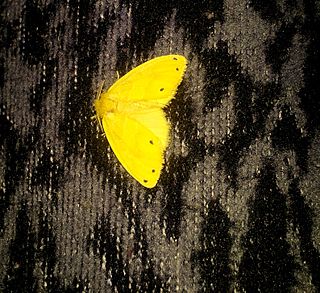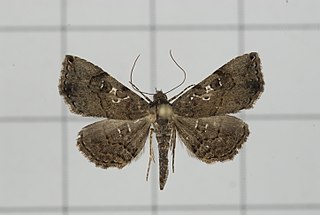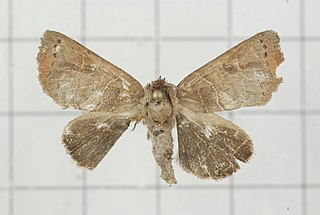Labanda is a genus of moths of the family Nolidae erected by Francis Walker in 1859.
Dunira is a genus of moths of the family Erebidae. The genus was described by Moore in 1885.

Tephriopis is a monotypic moth genus of the family Erebidae. Its only species, Tephriopis divulsa, was first described by Francis Walker in 1865.

Artaxa is a genus of tussock moths in the family Erebidae erected by Francis Walker in 1855. Some of the species have urticating hairs.

Rhesala imparata is a moth of the family Erebidae first described by Francis Walker in 1865. It is sometimes referred to as an Albizia defoliator. It is found in Sri Lanka, India, Taiwan, Singapore and Borneo.
Saroba ceylonica is a moth of the family Noctuidae first described by Francis Walker in 1865. It is found in the Indian subregion, the Andaman Islands, Singapore, Sumatra, Borneo and Sri Lanka.
Saroba pustulifera is a moth of the family Noctuidae first described by Francis Walker in 1865. It is found in the Indian subregion, Hong Kong, Thailand, Sundaland, Sulawesi and Sri Lanka.
Bembina apicalis is a moth of the family Erebidae first described by Francis Walker in 1865. It is found in India and Sri Lanka.

Clostera restitura is a moth of the family Notodontidae first described by Francis Walker in 1865. It is found in Oriental tropics of India, Sri Lanka, and from Hong Kong to Sundaland.
Poeta quadrinotata is a moth of the family Notodontidae first described by Francis Walker in 1865. It is found in Sri Lanka, Peninsular Malaysia, Sumatra and Borneo.
Anigraea cinctipalpis is a moth of the family Noctuidae first described by Francis Walker in 1865. It is found in Indian subregion, Sri Lanka, Malaysia, Borneo, Philippines, New Guinea and Australia.
Acidon nigribasis is a moth of the family Erebidae first described by George Hampson in 1895. It is found in India, Sri Lanka, and Borneo.
Catada vagalis is a moth of the family Erebidae first described by Francis Walker in 1858. It is found in India, Sri Lanka, Peninsular Malaysia, Borneo and the Philippines.
Dichromia thermesialis is a moth of the family Erebidae first described by Francis Walker in 1866. It is found in India, Sri Lanka, China, Sumatra, Borneo and New Guinea.
Altha subnotata is a moth of the family Limacodidae first described by Francis Walker in 1865. It is found in Sri Lanka, India and Nepal.
Dysodia ignita is a moth of the family Thyrididae first described by Francis Walker in 1865. It is found in India, Sri Lanka and Bangladesh.
Dysodia viridatrix is a moth of the family Thyrididae first described by Francis Walker in 1858. It is found in India, Sri Lanka and Vietnam.
Mathoris loceusalis is a moth of the family Thyrididae first described by Francis Walker in 1859. It is found in India, Sri Lanka and Australia.
Pharambara micacealis is a moth of the family Thyrididae first described by Francis Walker in 1866. It is found in Sri Lanka, New Guinea and Australia.
Aiteta damnipennis is a moth of the family Nolidae first described by Francis Walker in 1865. It is found in Sri Lanka, India, Peninsular Malaysia, Sumatra, Borneo and Sulawesi.





